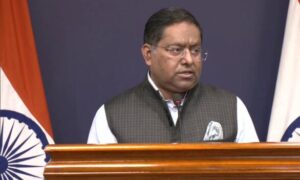
By Amar Diwakar
Partition is the sanguinary event upon which national identity in the Subcontinent pivots. Much like the Holocaust is to identity among Jews, it is seared painfully onto the South Asian consciousness by the memory of untold barbarism. As the historian Ayesha Jalal writes, Partition is “a defining moment that is neither beginning nor end” and it “continues to influence how the peoples and states of postcolonial South Asia envisage their past, present and future.”
Today, both India and Pakistan remain crippled by the narratives built around the chronicles of evil executed during their ham-handed deliverance from the yoke of colonial rule. The lunacy and bloodlust that commenced were piquantly captured by the pen of Saadat Hasan Manto, who experienced the traumatic schism first-hand during his reluctant relocation from Bombay to Lahore. In his most notable tale on Partition, “Toba Tek Singh,” Manto illuminates the psychosis that gripped the newborn nations in bitingly caustic fashion:
“ Two or three years after the 1947 Partition, it occurred to the governments of India and Pakistan to exchange their lunatics in the same manner as they had exchanged their criminals. The Muslim lunatics in India were to be sent over to Pakistan and the Hindu and Sikh lunatics in Pakistan asylums were to be handed over to India. It was difficult to say whether the proposal made any sense or not. However, the decision had been taken at the topmost level on both sides.”
It was from this smouldering cauldron of institutional depravity where the modern nation-building projects of South Asia would be harnessed. Indeed, the millions haplessly uprooted and wantonly butchered from both sides of the border still haunt the Subcontinent’s memory; the past can never be truly excised, for it is indelibly intertwined with the present. And so 70 years on, how does the memory of those traumatic wounds forged in 1947 continue to inform the configuration of identity and citizenship in India and Pakistan?
Independence from British colonialism operates as the foundation upon which the historic rupture for both India and Pakistan begins, but with a particular difference. For India, independence signaled the termination of foreign contagion and the opportunity to restore a nostalgic past; for Pakistan, liberation facilitated the inauguration of a secure polity for the region’s Muslims.
Their shared history was then promptly consigned to a collective ritual of forgetting. So deeply embedded into the fabric of nationhood is the traumatic kernel of Partition that from its wellspring a politics of selective memory was mobilized, and continues to be.
The collective memory of 1947 – of India’s “tryst with destiny” – is typically transmitted through an assortment of asymmetrical narratives, be it individual or parochial recollections scattered across its national geography. However, as the annual celebrations of independence indicate, the shocking statistics that were the byproduct of Partition (up to fifteen million displaced, two million killed, thousands of women kidnaped and raped) are conspicuously absent from the cacophony of jingoistic tributes. Rather, it is the memory of how far the polity has matured from a position of external domination, and forged a path of self-determination replete with parades of military muscle that is exclusively exhibited.
We can see that in the forgetting of partition trauma, India and Pakistan colonize a sense of time by correlating certain events with important dates, so that trauma can be disregarded. If we are to take on board Benedict Anderson’s claim that the nation is an “imagined community”, then we can understand nations as communities of constructed memories whose identity resides in having traits of culture, religion, ethnicity, and experiences in common.
Only by exploring the relationship between collective memory, democracy, and the partition, might we begin to understand how 1947 reformulated not only notions of citizenship and belonging, but those of difference and otherness as well. In response to the psychologically enforced amnesia of partition, Jacques Derrida’s notion of “hauntology” is particularly useful in understanding how the recuperation of memory distorts notions of linear history and temporality.
Hauntology refers to a past which is not, yet which is simultaneously present. Derrida’s figure of the “ghost” are the traces of those who have not been allowed to leave a trace; that disrupts linear concepts of time so that the present is never static or singular. Thus, the present is psychically interrupted by the past and even the future. Through this rupture of the present, ghosts gesture toward unresolved history and pasts that are impossible to forget.
This specter surrounding partition and the meaning of citizenship following 1947 has become even more visible today with Hindu nationalist rule in India. The Indian Republic, long underpinned by a postcolonial nationalist ideology which was governed under a Nehruvian consensus, is today under siege by an aggressive, totalizing vision of nationalism and what it means to be “Indian”. Are we witnessing the mutation from one version of Indian nationalism to another, albeit more exclusionary form hinged upon the resolved tensions of partition?
Through an appraisal of the tropes that have contributed to the official and intellectual narrative of “Indian exceptionalism” – historical continuity, unity in diversity, numerical democracy, and secular multiconfessionality – one might argue that this ideological scaffolding has always been fraught with contradictions from the Republic’s very inception. The failure to adequately reconcile the complex social and political realities of post-partition has now given way to a revanchist moment where a politics of “Hindu resentment” has been activated, harnessing and accelerating the fissures of those contradictions towards a theocratic horizon.
As Faiz Ahmed Faiz wrote in his poem The Dawn of Freedom, he expresses the sorrow of partition on two levels: the carnage that accompanied it and the disappointment that the freedom that came was not brought about by armed revolution. In melancholic ambiguity, he begins:
“This light, smeared and spotted, this night-bitten dawn
This isn’t surely the dawn we waited for so eagerly”
If the beginning was accusatory, the end was a call to arms:
“The weight of the night hasn’t lifted yet
The moment for the emancipation of the eyes
and the heart hasn’t come yet
Let’s go on, we haven’t reached the destination yet”
And so the specter of 1947 continues to haunt the South Asian nation-state. The promises of freedom for the multitude remain unfulfilled, as, in the interregnum, barbarism slowly immerses the Subcontinent towards a point of no return.
Amar Diwakar is a writer and research consultant with Global Risk Intelligence. Amar has an MSc in International Politics from SOAS, University of London. This article first appeared on Splintered Eye. To read the original article click HERE.
Views expressed here are personal.


















